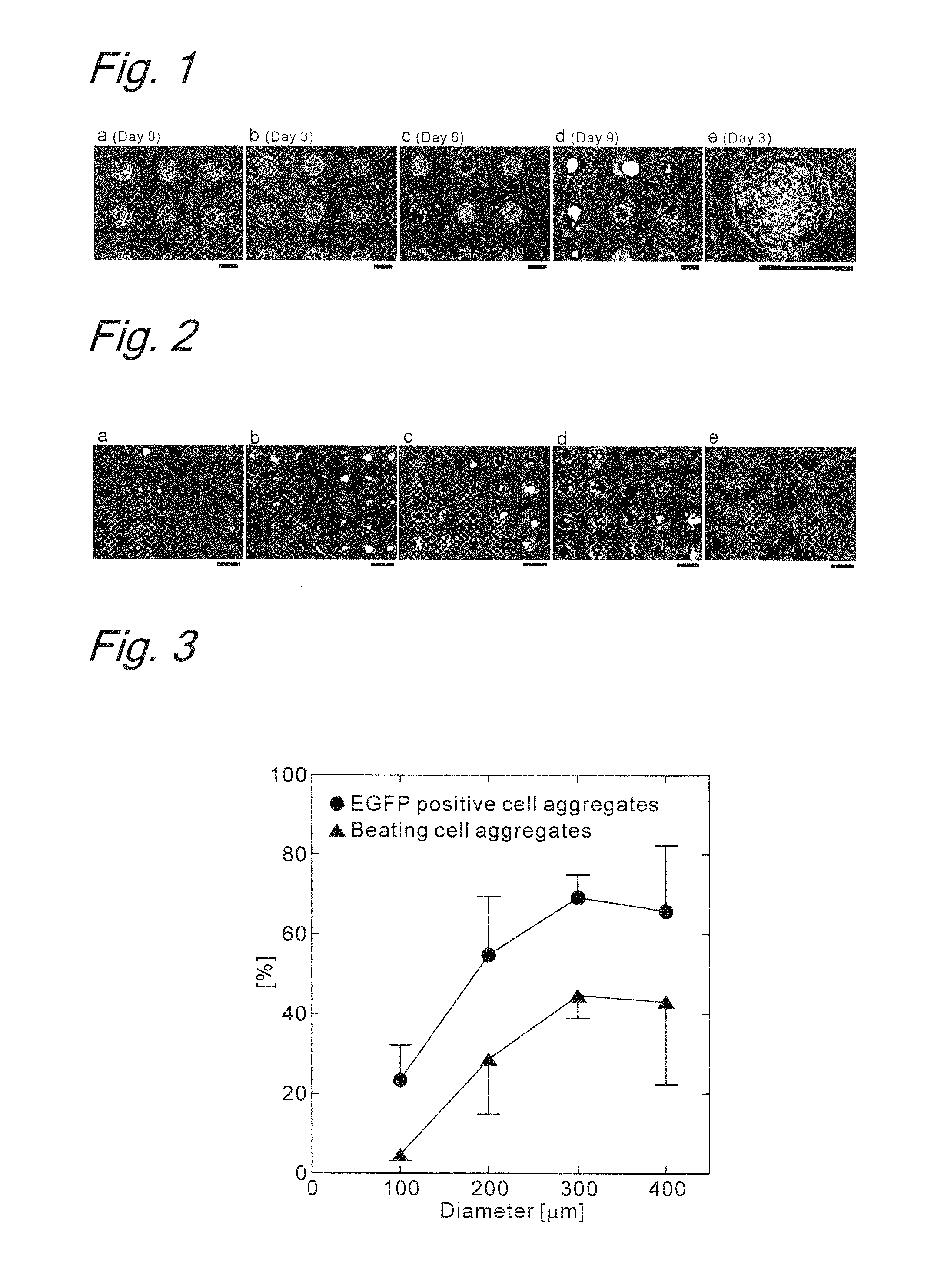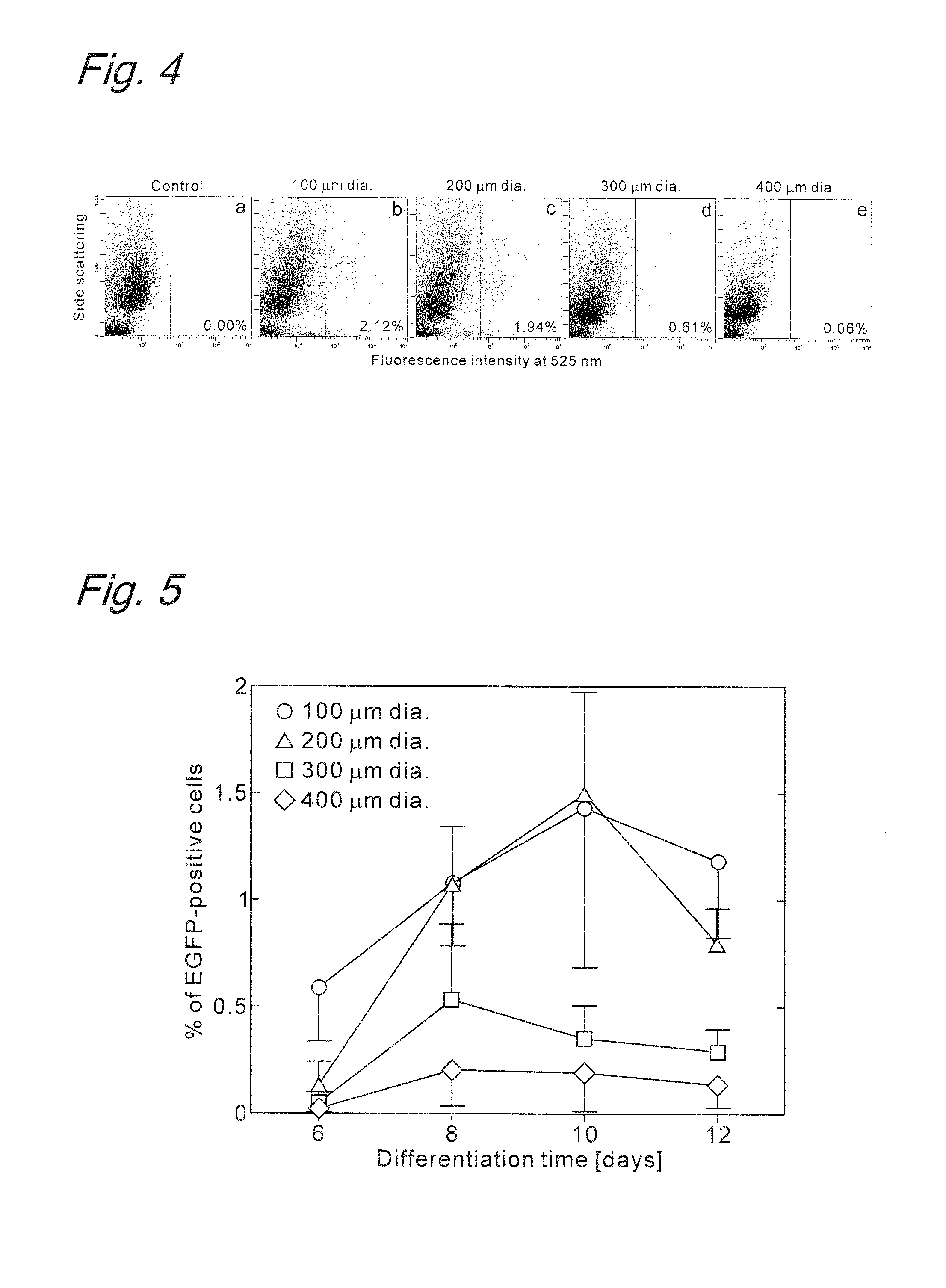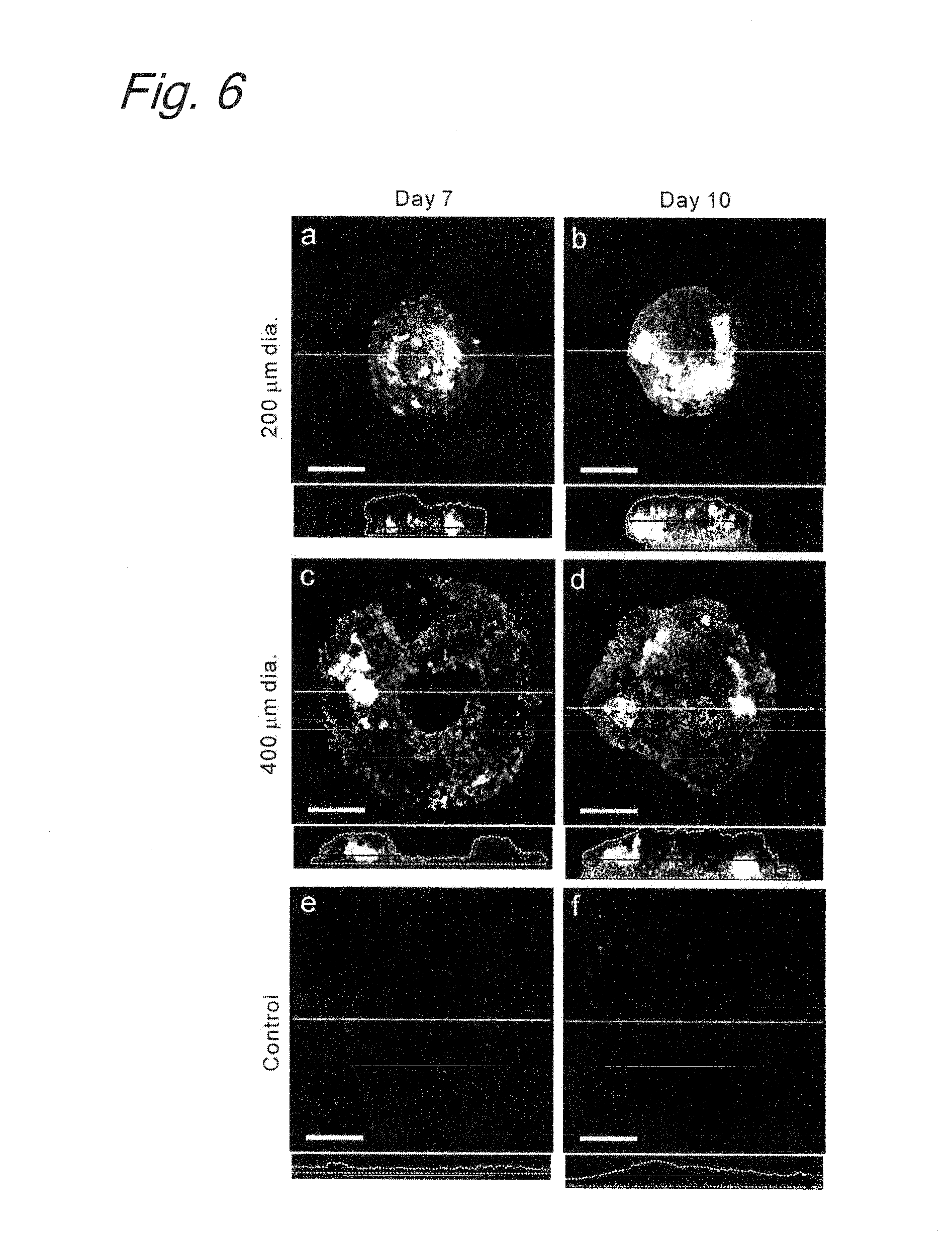Method for inducing differentiation of embryonic stem cells or artificial pluripotent stem cells
a technology of embryonic stem cells and stem cells, which is applied in the field of inducing embryonic stem cells or artificial pluripotent stem cells to differentiate, can solve the problems of complicated procedures and difficulty in preparing a large number of embryoid bodies
- Summary
- Abstract
- Description
- Claims
- Application Information
AI Technical Summary
Benefits of technology
Problems solved by technology
Method used
Image
Examples
example 1
[0042]Reagents
[0043]Reagents used in Example 1 are as follows.
[0044]3-Methacryloxypropyltrimethoxysilane (MPTMS) was purchased from Shin-Etsu Chemical Co., Ltd. A g-line positive photoresist (OFPR-800LB, 34 cP) and a developing solution (NMD-3) were purchased from Tokyo Ohka Kogyo Co., Ltd. Acrylamide, N,N′-methylenebisacrylamide, ammonium persulfate, sodium hydrogen carbonate, sodium chloride, potassium chloride, magnesium sulfate, sodium pyruvate, taurine, sodium hydroxide, calcium chloride, dipotassium hydrogen phosphate, creatine, potassium hydroxide, and paraformaldehyde were purchased from Wako Pure Chemical Industries, Ltd. N,N,N′,N′-Tetramethylethylenediamine (TEMED) and glucose were purchased from Kanto Chemical Co., Inc. D-PBS, Minimum Essential Medium Eagle Alpha Modification (α-MEM, Product Number: M0644), HEPES, and Na2ATP were purchased from Sigma-Aldrich Japan K.K. Fibronectin was purchased from Biomedical Technologies Inc. Fetal calf serum was purchased from Nichirei...
example 2
[0059]Reagents
[0060]Reagents used in Example 2 are shown below.
[0061]3-Methacryloxypropyltrimethoxysilane (MPTMS) was purchased from Shin-Etsu Chemical Co., Ltd. A g-line positive photoresist (OFPR-800LB, 34 cP) and a developing solution (NMD-3) were purchased from Tokyo Ohka Kogyo Co., Ltd. Acrylamide, N,N′-methylenebisacrylamide, ammonium persulfate, sodium hydrogen carbonate, sodium chloride, potassium chloride, magnesium sulfate, sodium pyruvate, taurine, sodium hydroxide, calcium chloride, dipotassium hydrogen phosphate, creatine, potassium hydroxide, and L-ascorbic acid phosphate trisodium salt were purchased from Wako Pure Chemical Industries, Ltd. N,N,N′,N′-Tetramethylethylenediamine (TEMED) and glucose were purchased from Kanto Chemical Co., Inc. D-PBS, Minimum Essential Medium Eagle Alpha Modification (α-MEM, Product Number: M0644), HEPES, and Na2ATP were purchased from Sigma-Aldrich Japan K.K. Fibronectin was purchased from Becton, Dickinson and Company. Fetal calf serum ...
example 3
[0072]Reagents
[0073]Reagents used in Example 3 are as follows.
[0074]3-Methacryloxypropyltrimethoxysilane (MPTMS) was purchased from Shin-Etsu Chemical Co., Ltd. A g-line positive photoresist (OFPR-800LB, 34 cP) and a developing solution (NMD-3) were purchased from Tokyo Ohka Kogyo Co., Ltd. Acrylamide, N,N′-methylenebisacrylamide, ammonium persulfate, sodium hydrogen carbonate, and L-ascorbic acid phosphate trisodium salt were purchased from Wako Pure Chemical Industries, Ltd. N,N,N′,N′-Tetramethylethylenediamine (TEMED) and glucose were purchased from Kanto Chemical Co., Inc. D-PBS and Minimum Essential Medium Eagle Alpha Modification (α-MEM, Product Number: M0644) were purchased from Sigma-Aldrich Japan K.K. Fibronectin was purchased from Becton, Dickinson and Company. Fetal calf serum was purchased from Nichirei Biosciences Inc. 2-Mercaptoethanol, penicillin-streptomycin, and TrypLE™ Express were purchased from Invitrogen Corp.
[0075]Production of Cell Patterning Culture Substrate...
PUM
| Property | Measurement | Unit |
|---|---|---|
| Time | aaaaa | aaaaa |
| Distance | aaaaa | aaaaa |
| Temperature | aaaaa | aaaaa |
Abstract
Description
Claims
Application Information
 Login to View More
Login to View More - R&D
- Intellectual Property
- Life Sciences
- Materials
- Tech Scout
- Unparalleled Data Quality
- Higher Quality Content
- 60% Fewer Hallucinations
Browse by: Latest US Patents, China's latest patents, Technical Efficacy Thesaurus, Application Domain, Technology Topic, Popular Technical Reports.
© 2025 PatSnap. All rights reserved.Legal|Privacy policy|Modern Slavery Act Transparency Statement|Sitemap|About US| Contact US: help@patsnap.com



